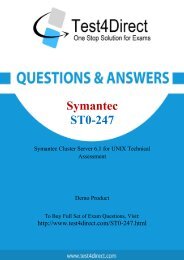RH202 Real Exam BrainDumps Updated 2016
Test4Direct provides latest PDF questions of RedHat RH202 exam. You have an opportunity to pass the RedHat RH202 exam in one go. Test4Direct is most accurate source to prepare RedHat RH202 exam as your success will become site’s responsibility after purchasing RH202 exam product. There are also lots of discounts and promotion offers that you can avail. Let’s try a free demo http://www.test4direct.com/RH202.html
Test4Direct provides latest PDF questions of RedHat RH202 exam. You have an opportunity to pass the RedHat RH202 exam in one go. Test4Direct is most accurate source to prepare RedHat RH202 exam as your success will become site’s responsibility after purchasing RH202 exam product. There are also lots of discounts and promotion offers that you can avail. Let’s try a free demo http://www.test4direct.com/RH202.html
Create successful ePaper yourself
Turn your PDF publications into a flip-book with our unique Google optimized e-Paper software.
RedHat<br />
<strong>RH202</strong><br />
Red hat Certified Technician on Red hat Enterprise Linux<br />
Demo Product<br />
To Buy Full Set of <strong>Exam</strong> Questions, Visit:<br />
http://www.test4direct.com/<strong>RH202</strong>.html
Question: 1<br />
Change the root Password to redtophat<br />
Answer and Explanation:<br />
Boot the system in Single user mode<br />
Use the passwd command<br />
Question: 2<br />
Dig Server1.example.com, Resolve to successfully through DNS Where DNS server is 172.24.254.254<br />
Answer and Explanation:<br />
#vi /etc/resolv.conf nameserver 172.24.254.254 # dig server1.example.com #host<br />
server1.example.com DNS is the Domain Name System, which maintains a database that can help<br />
your computer translate domain names such as www.redhat.com to IP addresses such as<br />
216.148.218.197. As no individual DNS server is large enough to keep a database for the entire<br />
Internet, they can refer requests to other DNS servers. DNS is based on the named daemon, which is<br />
built on the BIND (Berkeley Internet Name Domain) package developed through the Internet<br />
Software Consortium Users wants to access by name so DNS will interpret the name into ip address.<br />
You need to specify the Address if DNS server in each and every client machine. In Redhat Enterprise<br />
Linux, you need to specify the DNS server into /etc/resolv.conf file. After Specifying the DNS server<br />
address, you can verify using host, dig and nslookup commands.<br />
Question: 3<br />
Create the partition having 100MB size and mount it on /mnt/neo<br />
Answer and Explanation:<br />
Use fdisk /dev/hda To create new partition.<br />
Type n For New partitions<br />
It will ask for Logical or Primary Partitions. Press l for logical.<br />
It will ask for the Starting Cylinder: Use the Default by pressing Enter Key.<br />
Type the Size: +100M You can Specify either Last cylinder of Size here.<br />
Press P to verify the partitions lists and remember the partitions name.<br />
Press w to write on partitions table.<br />
Either Reboot or use partprobe command.<br />
Use mkfs -t ext3 /dev/hda? ->Where ? is your partition number<br />
Or mke2fs -j /dev/hda? To create ext3 filesystem.<br />
mkdir /mnt/neo<br />
vi /etc/fstab<br />
Write:<br />
/dev/hda? /mnt/neo ext3 defaults 1 2<br />
Verify by mounting on current Sessions also:<br />
mount /dev/hda? /mnt/neo
Question: 4<br />
Your System is going use as a router for 172.24.0.0/16 and 172.25.0.0/16. Enable the IP Forwarding.<br />
Answer and Explanation:<br />
echo "1" >/proc/sys/net/ipv4/ip_forward<br />
vi /etc/sysctl.conf net.ipv4.ip_forward=1 /proc is the virtual filesystem, containing the information<br />
about the running kernel. To change the parameter of running kernel you should modify on /proc.<br />
From Next reboot the system, kernel will take the value from /etc/sysctl.conf.<br />
Question: 5<br />
Some users home directory is shared from your system. Using showmount -e localhost command,<br />
the shared directory is not shown. Make access the shared users home directory.<br />
Answer and Explanation:<br />
Verify the File whether Shared or not ? : cat /etc/exports<br />
Start the nfs service: service nfs start<br />
Start the portmap service: service portmap start<br />
Make automatically start the nfs service on next reboot: chkconfig nfs on<br />
Make automatically start the portmap service on next reboot: chkconfig portmap on<br />
Verify either sharing or not: showmount -e localhost<br />
Check that default firewall is running on system ? if running flush the iptables using iptables -F and<br />
stop the iptables service.<br />
Question: 6<br />
neo user tried by: dd if=/dev/zero of=/home/neo/somefile bs=1024 count=70 files created<br />
successfully. Again neo tried to create file having 70K using following command: dd if=/dev/zero<br />
of=/home/neo/somefile bs=1024 count=70 But he is unable to create the file. Make the user can<br />
create the file less then 70K.<br />
Answer and Explanation:<br />
Very Tricky question from redhat. Actually question is giving scenario to you to implement quota to<br />
neo user. You should apply the quota to neo user on /home that neo user shouldn't occupied space<br />
more than 70K.<br />
1. vi /etc/fstab<br />
LABEL=/home /home ext3 defaults,usrquota 0 0 -> To enable the quota on filesystem you<br />
should mount the filesystem with usrquota for user quota and grpquota for group quota.<br />
touch /home/aquota.user-> Creating blank quota database file.<br />
mount -o remount /home ->Remounting the /home with updated mount options. You can verify that<br />
/home is mounted with usrquota options or not using mount command.<br />
quotacheck -u /home ->Initialization the quota on /home<br />
edquota -u neo /home-> Quota Policy editor<br />
See the snapshot 1 Disk quotas for user neo (uid 500): 2 Filesystem blocks soft hard inodes soft hard<br />
4 /dev/mapper/vo-myvol 2 30 70 1 0 0 Can you set the hard limit 70 and soft limit as you<br />
think like 30. Verify using the repquota /home command.<br />
Question: 7
One Logical Volume is created named as myvol under vo volume group and is mounted. The Initial<br />
Size of that Logical Volume is 124MB. Make successfully that the size of Logical Volume 245MB<br />
without losing any data. The size of logical volume 240MB to 255MB will be acceptable.<br />
Answer and Explanation:<br />
First check the size of Logical Volume: lvdisplay /dev/vo/myvol<br />
Increase the Size of Logical Volume: lvextend -L+121M /dev/vo/myvol<br />
Make Available the size on online: resize2fs /dev/vo/myvol<br />
Verify the Size of Logical Volume: lvdisplay /dev/vo/myvol<br />
Verify that the size comes in online or not: df -h We can extend the size of logical Volume using the<br />
lvextend command. As well as to decrease the size of Logical Volume, use the lvresize command. In<br />
LVM v2 we can extend the size of Logical Volume without unmount as well as we can bring the actual<br />
size of Logical Volume on online using ext2online command.<br />
Question: 8<br />
Quota is implemented on /data but not working properly. Find out the Problem and implement the<br />
quota to user1 to have a soft limit 60 inodes (files) and hard limit of 70 inodes (files).<br />
Answer and Explanation:<br />
Quotas are used to limit a user's or a group of users' ability to consume disk space. This prevents a<br />
small group of users from monopolizing disk capacity and potentially interfering with other users or<br />
the entire system. Disk quotas are commonly used by ISPs, by Web hosting companies, on FTP sites,<br />
and on corporate file servers to ensure continued availability of their systems. Without quotas, one<br />
or more users can upload files on an FTP server to the point of filling a filesystem. Once the affected<br />
partition is full, other users are effectively denied upload access to the disk. This is also a reason to<br />
mount different filesystem directories on different partitions. For example, if you only had partitions<br />
for your root (/) directory and swap space, someone uploading to your computer could fill up all of<br />
the space in your root directory (/). Without at least a little free space in the root directory (/), your<br />
system could become unstable or even crash. You have two ways to set quotas for users. You can<br />
limit users by inodes or by kilobytesized disk blocks. Every Linux file requires an inode. Therefore,<br />
you can limit users by the number of files or by absolute space. You can set up different quotas for<br />
different filesystems. For example, you can set different quotas for users on the /home and /tmp<br />
directories if they are mounted on their own partitions. Limits on disk blocks restrict the amount of<br />
disk space available to a user on your system. Older versions of Red Hat Linux included LinuxConf,<br />
which included a graphical tool to configure quotas. As of this writing, Red Hat no longer has a<br />
graphical quota configuration tool. Today, you can configure quotas on RHEL only through the<br />
command line interface.<br />
vi /etc/fstab<br />
/dev/hda 11 /data ext3 defaults,usrquota 1 2<br />
Either Reboot the System or remount the partition.<br />
Mount -o remount /dev/hda11 /data<br />
touch /data/aquota.user<br />
quotacheck -ufm /data<br />
quotaon -u /data<br />
edquota -u user1 /data and Specified the Soft limit and hard limit on opened file. To verify either<br />
quota is working or not: Soft limit specify the limit to generate warnings to users and hard limit can't<br />
cross by the user. Use the quota command or repquota command to monitor the quota information.
Question: 9<br />
One Logical Volume named lv1 is created under vg0. The Initial Size of that Logical Volume is 100MB.<br />
Now you required the size 500MB. Make successfully the size of that Logical Volume 500M without<br />
losing any data. As well as size should be increased online.<br />
Answer and Explanation:<br />
The LVM system organizes hard disks into Logical Volume (LV) groups. Essentially, physical hard disk<br />
partitions (or possibly RAID arrays) are set up in a bunch of equalsized<br />
chunks known as Physical Extents (PE). As there are several other concepts associated with the LVM<br />
system, let's start with some basic definitions:<br />
Physical Volume (PV) is the standard partition that you add to the LVM mix. Normally, a<br />
physical volume is a standard primary or logical partition. It can also be a RAID array.<br />
Physical Extent (PE) is a chunk of disk space. Every PV is divided into a number<br />
of equal sized PEs. Every PE in a LV group is the same size. Different LV groups can have<br />
different sized PEs.<br />
Logical Extent (LE) is also a chunk of disk space. Every LE is mapped to a specific PE.<br />
Logical Volume (LV) is composed of a group of LEs. You can mount a<br />
filesystem such as<br />
/home and /var on an LV.<br />
Volume Group (VG) is composed of a group of LVs. It is the organizational group for LVM.<br />
Most of the commands that you'll use apply to a specific VG.<br />
Verify the size of Logical Volume: lvdisplay /dev/vg0/lv1<br />
Verify the Size on mounted directory: df -h or df -h mounted directory name<br />
Use : lvextend -L+400M /dev/vg0/lv1<br />
resize2fs /dev/vg0/lv1 to bring extended size online.<br />
Again Verify using lvdisplay and df -h command.<br />
Question: 10<br />
Create one partitions having size 100MB and mount it on /data.<br />
Answer and Explanation:<br />
Use fdisk /dev/hda-> To create new partition.<br />
Type n-> For New partitions<br />
It will ask for Logical or Primary Partitions. Press l for logical.<br />
It will ask for the Starting Cylinder: Use the Default by pressing Enter Key.<br />
Type the Size: +100M-> You can Specify either Last cylinder of Size here.<br />
Press P to verify the partitions lists and remember the partitions name.<br />
Press w to write on partitions table.<br />
Either Reboot or use partprobe command.<br />
Use mkfs -t ext3 /dev/hda?Or mke2fs -j /dev/hda?-> To create ext3 filesystem.<br />
vi /etc/fstab Write: /dev/hda? /data ext3 defaults 1 2<br />
Verify by mounting on current Sessions also: mount /dev/hda? /data<br />
Question: 11<br />
You are new System Administrator and from now you are going to handle the system and your main<br />
task is Network monitoring, Backup and Restore. But you don't know the root password. Change the<br />
root password to redhat and login in<br />
default Runlevel.
Answer and Explanation:<br />
When you Boot the System, it starts on default Runlevel specified in /etc/inittab: Id:?:initdefault:<br />
When System Successfully boot, it will ask for username and password. But you don't know the root's<br />
password. To change the root password you need to boot the system into single user mode. You can<br />
pass the kernel arguments from the boot loader.<br />
Restart the System.<br />
You will get the boot loader GRUB screen.<br />
Press a and type 1 or s for single mode ro root=LABEL=/ rhgb queit s<br />
System will boot on Single User mode.<br />
Use passwd command to change.<br />
Press ctrl+d<br />
Question: 12<br />
There are more then 400 Computers in your Office. You are appointed as a System Administrator. But<br />
you don't have Router. So, you are going to use your One Linux Server as a Router. How will you<br />
enable IP packets forward?<br />
Answer and Explanation:<br />
/proc is the virtual filesystem, we use /proc to modify the kernel parameters at running time. # echo<br />
"1" >/proc/sys/net/ipv4/ip_forward<br />
/etc/sysctl.conf when System Reboot on next time, /etc/rc.d/rc.sysinit scripts reads the file<br />
/etc/sysctl.conf. To enable the IP forwarding on next reboot also you need to set the parameter.<br />
net.ipv4.ip_forward=1 Here 0 means disable, 1 means enable.<br />
Question: 13<br />
You Completely Install the Redhat Enterprise Linux 5 on your System. While start the system, it's<br />
giving error to load X window System. How will you fix that problem and make boot successfully run<br />
X Window System.<br />
Answer and Explanation:<br />
Think while Problems occurred on booting System on Runlevel 5 (X Window).<br />
/tmp is full or not<br />
Quota is already reached<br />
Video card or resolution or monitor is misconfigured.<br />
xfs service is running or not. Do These:<br />
df -h /tmp /tmp-> is full remove the unnecessary file<br />
quota username-> if quota is already reached remove unnecessary file from home directory.<br />
Boot the System in runlevel 3. ->you can pass the Kernel Argument from boot loader.<br />
Use command: system-config-display->It will display a dialog to configure the monitor, Video card,<br />
resolution etc.<br />
Set the Default Runlevel 5 in /etc/inittab id:5:initdefault:<br />
Reboot the System you will get the GUI login Screen.<br />
Question: 14<br />
There are two different networks, 192.168.0.0/24 and 192.168.1.0/24. Your System is in
192.168.0.0/24 Network. One RHEL 5 Installed System is going to use as a Router. All required<br />
configuration is already done on Linux Server. Where<br />
192.168.0.254 and 192.168.1.254 IP Address are assigned on that Server. How will make successfully<br />
ping to 192.168.1.0/24 Network's Host?<br />
Answer and Explanation:<br />
1. vi /etc/sysconfig/network<br />
GATEWAY=192.168.0.254 OR vi /etc/sysconf/network-scripts/ifcfg-eth0<br />
DEVICE=eth0 BOOTPROTO=static ONBOOT=yes IPADDR=192.168.0.? NETMASK=255.255.255.0<br />
GATEWAY=192.168.0.254<br />
2. service network restart<br />
Explanation: Gateway defines the way to exit the packets. According to QUESTION System working as<br />
a router for two networks have IP Address 192.168.0.254 and 192.168.1.254. To get the hosts on<br />
192.168.1.0/24 should go through 192.168.0.254.<br />
Question: 15<br />
Make a swap partition having 100MB. Make Automatically Usable at System Boot Time.<br />
Answer and Explanation:<br />
Use fdisk /dev/hda ->To create new partition.<br />
Type n ->For New partition<br />
It will ask for Logical or Primary Partitions. Press l for logical.<br />
It will ask for the Starting Cylinder: Use the Default by pressing Enter Key.<br />
Type the Size: +100M ->You can Specify either Last cylinder of Size here.<br />
Press P to verify the partitions lists and remember the partitions name. Default System ID is 83 that<br />
means Linux Native.<br />
Type t to change the System ID of partition.<br />
Type Partition Number<br />
Type 82 that means Linux Swap.<br />
Press w to write on partitions table.<br />
Either Reboot or use partprobe command.<br />
mkswap /dev/hda?-> To create Swap File system on partition.<br />
swapon /dev/hda? ->To enable the Swap space from partition.<br />
free -m-> Verify Either Swap is enabled or not.<br />
vi /etc/fstab /dev/hda? swap swap defaults 0 0<br />
Reboot the System and verify that swap is automatically enabled or not.
THANKS FOR TRYING THE DEMO OF OUR PRODUCT<br />
Visit Our Site to Purchase the Full Set of Actual <strong>RH202</strong> <strong>Exam</strong> Questions With Answers.<br />
http://www.test4direct.com/<strong>RH202</strong>.html<br />
We Also Provide Practice <strong>Exam</strong> Software That Simulates <strong>Real</strong> <strong>Exam</strong> Environment And Has<br />
Many Self-Assessment Features. Download Free Product Demo From:<br />
http://www.test4direct.com/<strong>RH202</strong>.html<br />
Money Back Guarantee<br />
Check Out Our Customer Testimonials

















